Where the right-of-way crosses through Barbara Gard’s Sumas Mountain property, a narrow strip of land is scoured of everything but crabgrass. It looks like a massive ecological blemish — Paul Bunyan dragged his axe along the ground on his way to Vancouver.
A metre beneath the surface lurks a 1,150 kilometre-long pipe. It’s primarily used for transporting a hydrocarbon sludge, which has been diluted by other, lighter petroleum products to make it flow better. The unrefined oil comes from the Albertan tar sands.
A small part of Gard’s land belongs to the Trans Mountain pipeline. They’re responsible for the maintenance of the pipeline and so periodically, they clear the land above it. A tractor with a big mower buzz-cuts everything to keep it neat and tidy.
On her property, a couple dozen activists, concerned landowners, journalists, and filmmakers gathered around Gard to listen to her explain the history of her relationship with the oil company. Most came to replant trees that were removed by related pipeline work, so Gard gave a tour of her several acres to put the past into perspective. For some reason, contractors hired by Kinder Morgan, for the last four years, have been cutting trees beyond the company’s allotted 18 metres of width. But her contentions with their practice go much further than the treeline.
The Trans Mountain pipeline crosses the Rocky Mountains at Yellowhead Pass from Edmonton. It runs through Jasper National Park and Mount Robson Provincial Park, then curves south through the Coquihalla Canyon. From there it turns through the Fraser Valley towards Burnaby.
Kinder Morgan has rights to the strip of land where the pipeline lays through easement agreements. This “right-of-way” passage has existed for the over 60-year life of the pipeline. Any landowner with a pipeline right-of-way crossing through their property knows it’s land they can’t touch. But supposedly, the land beyond the right-of-way, Kinder Morgan can’t touch.
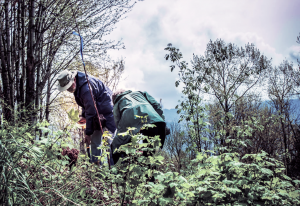
On March 21, 1951, the Trans Mountain Pipeline Company was created by a special act of Parliament. The pipeline provided oil to southern B.C. for the Asia and U.S. markets and was seen by some as a strategic move for defence against the Soviet threat.
Ownership of the company was split between Canadian Bechtel Ltd. and Standard Oil; construction began in 1952 and oil first flowed through the pipe on October 17, 1953. The pipeline has been in use ever since. Now, Trans Mountain is a wholly owned subsidiary of the Canadian division of Kinder Morgan.
In November last year, the Trudeau government approved the controversial pipeline’s proposed expansion — the pipeline’s “twinning.” That was when the Enbridge Line 3 pipeline also was approved, and the even more controversial Enbridge North Gateway pipeline to Kitimat, B.C., was rejected.
In January this year, Premier Christy Clark announced B.C.’s support for the expansion. Public perception of the approval was jaded, however, by political donations to the Liberal government. Activists allege hundreds of thousands of dollars in political donations to the Liberal party swayed the province’s decision. They’ve taking action since and filed a lawsuit with the B.C. Supreme Court.
The Province reported that the court application names Premier Christy Clark, Environment Minister Mary Polak, and Natural Gas Development Minister Rich Coleman as being in an apparent conflict of interest when they approved the Kinder Morgan Trans Mountain pipeline in January. It also alleges that Clark’s conflict was compounded by personally benefiting from $50,000 annually from the party for a total of $300,000 during the five years.
The lawsuit alleges that “a rational and informed observer would conclude that because of the payment of approximately $560,000 by the interested companies, including Kinder Morgan, to the Liberal party … it is more likely than not that the premier and the ministers were consciously or unconsciously affected by these enormous payments.”
The original court date was set for April 12, but it was adjourned to May 3 because the Liberal’s lawyer needed more time to respond. Regardless of the findings, B.C. has no legal authority to block the expansion. In 2010, B.C. signed away its environmental assessment rights through an “equivalency agreement” which gives Ottawa all the power.
Back to 1953, at the genesis of the pipeline’s dynasty, the pipeline’s capacity was 150,000 barrels per day (bbl/d). The line had four pump stations and a marine loading dock. Since it was built, the capacity of the system has been increased multiple times.
Currently, the system is about 1,150 kilometers long from Edmonton to Burnaby with 23 pump stations along the route maintaining its 300,000 bbl/d capacity. In addition to the pump stations, there are also multiple terminals that connect to “feeder” pipelines and tanker loading facilities. One of these terminals sits on Abbotsford’s Sumas Mountain. From here, the pipeline routes its contents down to either the Puget Sound system for delivery to Washington State refineries, or to the Burnaby marine terminal.
On December 16, 2013 the Trans Mountain Pipeline ULC applied to the National Energy Board (NEB) for approval of the expansion project. If approved, the project would expand the system and nearly triple its capacity from 300,000 bbl/d to 890,000 bbl/d.
To try and put that into perspective; there are 158.99 litres in a barrel. That approximately works out to 148,948,526 (148.9 million) Nalgene bottles per day.
Barbara Gard has had a great view of the approval and development process from her home on Sumas Mountain. The scenic view she once had from her house has been destroyed, she says. But it has redirected her gaze to what’s causing the harm to her property.
In the last several years, Kinder Morgan has cut hundreds of trees on Gard’s property. According to Gard, the major changes came in December 2013, which would have been right around when Trans Mountain applied for the expansion.
Kinder Morgan told Gard they would cut trees to clear their right-of-way. As a landowner with an easement through her property, Gard doesn’t have any right to say no. But according to Gard, they told her she wouldn’t even know they were there once finished trimming. They were going to survey then spend two days cutting trees and would do it while the ground was frozen in the winter in order to not disturb the ground.
“Well what happened? They did not tag the trees, they did not survey it, they came in with heavy equipment and for seven days they cut and they mulched,” she said. “I came down afterwards and just cried.”
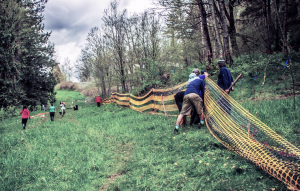
Gard is a gentle woman, and sharp as a tack. You wouldn’t expect someone kicking around in gumboots to rattle off species names, laws, and environmental legislation the way she can. From her home, Gard runs a dog rescue nonprofit. She lives where she does because it allows her to keep her dogs and goats safely. Her property is mostly forested. She said that to her, her forest is just another kind of rose garden.
“The right-of-way was not surveyed prior to the clearing, trees to be removed were not identified in advance, and an environmental inventory of at risk species was not conducted on my property.”
Sumas Mountain is known to be inhabited by at least 40 species at risk and 27 ecosystems at risk. It’s one of the few remaining somewhat untouched forests in the Fraser Valley. That’s why local landowners and activists are concerned about changes to the Sumas Mountain ecosystem.
To make a statement, dozens of activists and affected landowners organized a tree planting and fence building extravaganza. I watched as the group planted nearly 200 trees in Kinder Morgan’s prescribed area (the land just outside of their right-of-way), which is still and will continue to be Gard’s property. The fence was erected along the right-of-way. It was done to make it clear to Kinder Morgan where the property lines are.
Although Kinder Morgan prohibits digging within the pipeline boundary, apparently going down 30 centimetres is allowed. So that’s how deep the trees went.
Justine Nelson organized most of the tree planting event. She has a bachelor of applied arts from Kwantlen Polytechnic University and is working on a master of education for sustainability at UBC. She’s also the chapter coordinator for the Pipe Up network, an anti-pipeline advocacy group.
“We’re working to replant native trees to help restore the ecosystem — Kinder Morgan has torn a lot of those trees down,” she said, while digging a hole for a sapling. “This property has been impacted by the existing Kinder Morgan pipeline and it’s the area where they proposed to twin the pipeline as well.”
When the pipeline goes through, this is what she expects to see everywhere.
“This is our problem, it’s our duty to hold Kinder Morgan accountable because the government isn’t going to,” Nelson said while filling dirt in around the tree. “As a community, if we want things to happen or things to change then we need to be out there watching what’s going on.”
Gard herself, is concerned about legal protection: “If my neighbour comes and cuts down my tree, under civil law that’s trespassing, I can sue them,” she said. “If they cut the root and kill the tree I can sue them, if they shear and kill the tree I can sue them. Kinder Morgan has done that so I asked if I have a right to sue them in civil court. Easy question for the National Energy Board, but they won’t give me the answer.”
She’s upset because Kinder Morgan cut far more trees than she believes they were supposed to. She’s spent years hand-trimming out the blackberry bushes that invaded her property when she bought the land in 2010. Every time Kinder Morgan mows, they cut all the native species back to the ground. Then the blackberries return.
“They’ve been on my land about 50-feet beyond their right-of-way. The whole length is about a thousand feet, so it’s about 50,000 sq feet on my land,” Gard said, roughly estimating while looking down the right-of-way.
“In effect, this so-called public hearing process has become a farce, and this Board a truly industry captured regulator”
Michael Hale is one of the tree planters; he feels way more can be done to protect the environment, and if the pipeline companies won’t do it, he will.
“What we were doing in support of the local landowner is putting back some of the trees that were removed by Kinder Morgan without any consultation,” Hale told me. “We’ve been planting back native species to try and reasonably bring this back to some resemblance of its former beauty.”
Hale is a sturdy man with a peaceful disposition. In an interview beside the McCallum Brook, which runs through Gard’s property, he explained some of the disagreement between Kinder Morgan and landowners.
“This is a riparian area alongside the stream here so there’s a bit of a clash between Kinder Morgan’s pipeline right-of-way and the set limits for a riparian zone, so they’re in conflict,” he said gesturing towards the stream.
“From the top of a creek bank, you’re supposed to have 15 metres that’s not drastically modified by humans. Kinder Morgan has their pipeline right-of-way and they want clear sight lines so they can fly over and see if there are any problems, so we’ve got a clear clash of interests.”
A riparian area is the interface zone between land and a stream. They’re the areas with moist or saturated soil, marshlands, water-loving plants, and everything associated with that ecosystem.
Riparian areas are everywhere in the Fraser Valley. If you didn’t play around one as a kid, you’ve at least walked through a park with a meandering stream and its riparian zone. These zones are extremely important for the broader ecosystem because they circulate nutrients between different habitats. Another name for riparian zones are “stream corridors” — that’s what they are, a corridor for fish, land animals, plant life, and nutrients.
Riparian areas are governed by multiple bodies. It falls under federal jurisdiction through the Department of Fisheries and Oceans (DFO), but it also belongs to the provincial government through the Ministry of Forests, Lands and Natural Resource Operations. Then, if they want, the City of Abbotsford can create by-laws to “meet or beat” provincial standards.
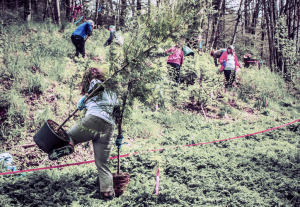
For several years now, Gard has been trying to figure out which environmental standards cover the stream on her property. According to her, everyone points the finger at someone else.
The Federal Fisheries Act requires that projects avoid causing harm to fish. This includes work done in or around water bodies supporting fish that are part of or support a commercial, recreational, or Aboriginal fishery. The part of the Fisheries Act that pertains to protecting key habitats and prohibiting fish habitat destruction is overseen by the DFO.
But as of a Memorandum of Understanding between the NEB and DFO in 2013, the NEB now assesses impacts if they relate to NEB regulated pipelines. In other words, NEB regulated pipelines’ associated environmental impacts are assessed by the NEB. The National Energy Board’s website says that under their MOU, “the NEB will assess the potential impacts of a project to fish and fish habitat, including aquatic species at risk in a manner that considers the intent and requirements of the Fisheries Act and the Species at Risk Act (SARA).”
In effect, the potential impact is assessed by the NEB. Only if they find that a project will impact a species at risk will the project have to make a separate submission to the DFO. So where does the NEB get their information from, and who does the NEB work for?
“I’m living with what all the environmentalists are worried about, but what all the politicians are saying we have protection for”
In 2012, the Harper government brought in their Environmental Assessment Act which cancelled thousands of environmental reviews and handed environmental project assessments to agencies like the NEB.
According to Jason Maclean writing for the Toronto Star, the 2012 changes were “lobbied for and literally written by industry advocates to reduce red tape and expedite project approvals.” It also “gutted” the Canadian Environmental Assessment Act, the National Energy Board Act, the Fisheries Act, and the Navigable Waters Protection Act.
Marc Eliesen, a senior energy executive who once served as CEO of BC Hydro, was a big player in the federal review of the pipeline expansion project. He had worked in the energy sector for 40 years and as CEO of BC Hydro, he ran the nation’s largest hydro utilities. He also served as chair of Manitoba Hydro, and as Ontario’s deputy minister of energy. In 2014, in the middle of the the review, Eliesen resigned.
In his letter of resignation from the NEB hearing, he said, “I have come to the conclusion that the Board, through its decisions, is engaged in a public deception. Continued involvement with this process is a waste of time and effort, and represents a disservice to the public interest because it endorses a fraudulent process.”
Some of his frustration came from changes to the hearing process: “I was dismayed” he writes, “when the oral cross-examination phase … was inexplicably removed from this hearing.”
He continues: “The unwillingness of Trans Mountain to address most of my questions and the Board’s almost complete endorsement of Trans Mountain’s decision has exposed this process as deceptive and misleading.”
“In effect, this so-called public hearing process has become a farce, and this Board a truly industry captured regulator.”
Eliesen’s concerns resonated with many involved with the review process.
In June 2016 however, the Trudeau federal government launched a review of Canada’s environmental laws. One of the independent panels was set specifically to review the NEB. Around that time, many accusations pointed to the NEB being in bed with the industry it watches over. This last April, less than a year from the review’s launch, the panel recommended a major overhaul to the environmental assessment process, the Globe and Mail reported. It was a welcomed announcement for many activists.

But back to the riparian area. If vegetation clearing from a riparian area is for maintenance of existing linear projects, the DFO is not required to review riparian vegetation removal. The Trans Mountain pipeline right-of-way is one of these “linear projects.” However, riparian vegetation removal is not allowed if it is identified as part of the critical habitat of a listed aquatic species at risk. So if the DFO had any reason to believe there were several endangered species living in or around the McCallum Brook, or “”watercourse 19” as per the applications, then decades of riparian vegetation removal might be considered illegal — certainly ongoing removal would be, without approval from the minister of Fisheries and Ocean Canada.
“We found dead Oregon forest snails throughout this area and around the area. I’ve asked them to log that this is forest snail area, but they won’t acknowledge that this is Oregon forestsnail habitat,” said Gard.
The Oregon forestsnail is listed as a schedule one endangered species. Having that classification protects the snail, and their habitat. The northern red-legged frog is another creature listed as a schedule one as a special concern species, as is the mountain beaver. The little Oregon forestsnail is small, but it can stop a development proposal train and create a bureaucratic nightmare. Gard and others say that they have seen many; they’ve also seen the red-legged frog and its friend, the mountain beaver.
“They’re the ones who told me about the Oregon forestsnail,” said Gard. “When they came on to clear, they very clearly knew that this was Oregon forestsnail land, but by mowing it all down they’ve destroyed the habitat.”
So what if you enter the proposed project’s region several years before assessment is required and clearcut the full habitat? Later on, there’s nothing to assess.
The riparian area removal didn’t stop with tree cutting, according to Gard.
“Kinder Morgan did an integrity dig in October 2015, this used to be wetland marsh, you couldn’t see the road,” said Gard, continuing the tour. She pointed to a section of the stream that was noticeably barren. “It was bulrushes and willows, about six metres wide. So when they took it out they put in rip rap and landscape fabric.” Rip rap is loose stones piled up to form a water break or stream bank. But by November 1, Gard said, the creek ran red.
In assessments approved by Kinder Morgan, the blame for the red water was placed upstream. But Gard pointed out that the stream didn’t turn red until after construction.
It’s possible that iron oxide is originating further upstream, as per the environmental assessment. A few hundred metres above is an aggregates mine and they’ve dug out the headwaters and replaced them with stormwater ponds. Wetlands are nature’s water filters. The riparian area that no longer exists could have been preventing whatever minerals or chemicals that leached in from further upstream from contaminating the water that Gard used to drink.
Back in 2012, an environmental assessment was conducted by an independent environmental consulting firm. It was done to determine if watercourses in the area would be affected by development unrelated to the pipeline.
The report says that their assessment was undertaken during typical weather through the year in the Fraser Valley which confirmed the permanency of McCallum Brook. This would classify the creek as a perennial — running throughout the year.
Kinder Morgan hired a company to do their own studies in 2016 to conduct stream channel and bank stabilization tests where the pipeline crosses. Their assessments were that McCallum Brook is an “ephemeral, non-fish bearing watercourse,” meaning that it’s a seasonal stream and doesn’t run year-round — or, a drainage ditch.
The contrast between the two reports is fairly stark. One says that the stream flows year round and the other says it doesn’t.
“Old reports call it a fish bearing perennial stream. But every report presented to the DFO or NEB calls it a non-fish bearing ephemeral stream,” said Gard. “Because it’s ephemeral to the NEB, there’s no riparian area and no protection. So this creek doesn’t exist to the NEB because there’s no room for a pipeline if it did.”
According to a Trans Mountain pipeline response to an information request, “Instream works associated with the integrity investigation … were conducted under a Section 9 Water Act Authorization.” Their response goes on to say that “Channel restoration specifications were designed and implemented to restore the preconstruction alignment and gradient of the watercourse with consideration of Section 11 of the Oil and Gas Activities Act Environmental Protection and Management Regulation.”
So the work was conducted under the Water Act and the restoration complied with the Oil and Gas Activities Act. But there’s nothing in those acts that protects riparian areas. The DFO says that riparian areas can’t be destroyed, B.C. has their own Fish Protection Act which includes the Riparian Areas Regulation, the Federal Fisheries Act says you can’t harm fish, and the Species at Risk Act prohibits harming any endangered species. But the pipeline right-of-way is regulated by the NEB, and since 2012, through the Harper government’s wildly unpopular Environmental Assessment Act, major energy product assessments are conducted by the NEB.
So who’s in charge of protecting the environment? That’s what Gard would like to know. It seems that the left hand doesn’t know what the right hand is doing. Or the right hand has no jurisdiction to oversee the left hand. Either way, Gard’s property is an example of what could be expected for the 643 officially classified water crossings.
All this means Kinder Morgan did nothing wrong — or at least, unlawful. They’ve obeyed legislation, which is minimal. In the words of Devon Page, executive director of the environmental law non-profit Ecojustice, “Canada has some of the worst environmental laws in the world.”
“When they did their anomaly dig [in 2015], this is what the engineer kept saying: ‘Oh I’m surprised, I wasn’t expecting to hit bedrock,’ ‘Oh I’m surprised there’s so much water,’” Gard said. “They’ve been told that it’s ephemeral and that there’s no water. When they came to do the dig they weren’t prepared for bedrock or water. They were given false information on what to base their designs. So the engineering design is based on inaccurate information.”
A similar problem came up in 2007 when a Kinder Morgan pipeline ruptured after being hit by an excavator, spewing almost 250,000 litres of oil into Burrard Inlet and Burnaby Bay. According to the Transport Safety Board, the pipeline was hit by a contractor’s excavator bucket while digging the trench for a new storm sewer line. The mistake was considered a “lack of communication” but was caused because there was a “discrepancy between its location [on the drawing] … and its actual field location.”
Original documents misplaced the location of the Burnaby pipeline — on Gard’s land, Kinder Morgan’s right-of-way is in the creek.
“I’m living with what all the environmentalists are worried about, but what all the politicians are saying we have protection for,” Gard told me as we walked down the easement.
Similarly in 2012, near Gard’s house, at the Kinder Morgan tank farm on top of Sumas Mountain, about 90,000 litres of crude oil escaped the pipeline. A gasket failed, which exposed the oil, but the main problem was that Trans Mountain pipeline operators ignored warning alarms for three-and-a-half hours before responding, the official report said.
Before that, in 2005, 210,000 litres of crude oil was released into the nearby area, some of which ended up in Kilgard Creek, a neighboring watercourse to McCallum Brook and supply to fish-bearing waters.
It’s ongoing stories like these that keep Gard worried about the future of her property, and the pipeline’s impact on the environment as a whole.
“I’ve been taken advantage of, badly mistreated. The oil companies are behaving like pirates, behaving one way and saying another”
Although the tree planting was aimed at restoring the property, the tree planters couldn’t do anything about the creek and its riparian area. The pipeline goes under the creek and tree planting on the right-of-way would be strictly prohibited. Besides, according to the Kinder Morgan report on their integrity dig, they already restored the creek.
“We don’t think it was restored, so there’s a clear difference in language. What does it mean to restore habitat once you’ve done a dig for a pipeline?” asked Hale.
Hale has had experience reconstructing streams. He’s volunteered his time to improve damaged waterways — that’s a claim only someone completely dedicated to environmental harmony can make. It also makes him an expert on stream health. In one of the communities where Hale lived, streams that ran through it had been modified by developers. As a member of the citizens association, he and the association worked to restore the community’s streams back to their natural state.
“In this case, they did [an integrity] dig because there was some anomaly, possibly a leak or something like that, and they dug down, fixed whatever it was then put it back,” Hale explained. “Supposedly as good as it was before, and what you get is now there is no vegetation, although they did plant a few trees but they didn’t survive.”
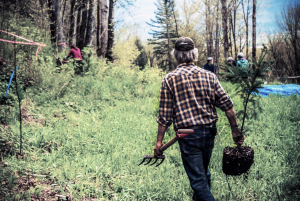
Dan Coulter is another owner of land with a pipeline running through it. He has an intimate relationship with Kinder Morgan and says he’s been to more meetings to try and express his concerns about safety and his property than he cares to count.
Coulter’s is an industrial property. He took a break from tree planting to tell me that his problem is that the pipeline nullifies about four acres of his land. He and the businesses operating there will be affected further when the pipeline twinning goes through. Because of the expansion, and the 2016 implementation of what’s called the Pipeline Safety Act, 30 additional metres on either side of the already allotted pipeline right-of-way will be given as a “prescribed area” to the Trans Mountain pipeline. There are landowners who don’t currently have the right-of-way cross their land but will now be in the prescribed area. No one gets paid for the prescribed area because it doesn’t belong to the right-of-way, but you can’t do anything on it because it’s “protected.”
“I’ve been taken advantage of, badly mistreated. The oil companies are behaving like pirates, behaving one way and saying another,” Coulter said, leaning on his shovel.
For Coulter, the changes to his property are a concern. What’s a bigger concern is that he believes oil infrastructure is completely outdated and Big Oil’s work on the ground is immoral regardless of where it happens.
“It’s nice to get out with the community of the concerned and reinforce each other in the work we see as absolutely essential to fight back and to try and bring exposure to how the government and industry glosses over systemic degradation — environmentally and socially — with their misrepresentation of what’s going on and their attempts to keep us in a pacified state with a lot of misinformation and outright lies,” he casually added.
In a report released last month, Simon Fraser University academic Tom Gunton argued that a pipeline would go to waste.
“Most young people agree I think — why would we lock ourselves into a 20th century infrastructure for 50 or more years?” said Hale. “The bottom line is there just won’t be markets then.”
According to the Vancouver Sun, Gunton argues that with all the projects under development (Trans Mountain expansion, Keystone XL, Energy East pipelines) along with recent forecasts that suggest much less growth in Canadian oil output, the country will end up with a “massive overcapacity to move oil.”
But, Trans Mountain’s website says the project will “increase the value of Canadian oil by unlocking access to world markets.” It also says it could benefit Aboriginal groups, future employees, and Canada as a whole through tax revenue.
Gunton’s findings say that Canada could end up with millions of barrels of excess pipeline capacity if it turns out the National Energy Board predictions about future oil demand fall short. It’s difficult to predict the future. It seems everyone predicts the future they desire.
As it stands today, pipeline construction will begin this year. Kinder Morgan is turning to the public to help pay for the project. Last week, the National Post reported that Kinder Morgan Canada filed for initial public offering (IPO) to raise funds for the expansion. Reuters reported in February that the company had engaged in talks with institutional investors to secure capital for the project. They were looking at either an IPO or joint venture.
The IPO means that this is the first time the private company’s stocks will be offered to the public. So if you’re interested, you’ll likely soon be able to buy Kinder Morgan Canada stocks.
Gard’s fight has gone on for several years. She says it’s wearing her out. But she continues to work with Pipe Up and other members of the “community of the concerned” to find a way to keep her land protected.
Pipelines are a difficult subject. Anything with so much money involved and such a far reaching influence is never simple. Gard herself admits that she’s so emotionally attached to her property that it’s difficult to participate in meetings with pipeline and NEB representatives. In this conversation, emotions run as deep as opinions differ wide.
Whether Kinder Morgan has their way or not might not even matter; at the end of the day, it’s not necessarily the pipeline that’s the problem, it’s the lack of environmental protection. In a phrase: “Canada has some of the worst environmental laws in the world.”
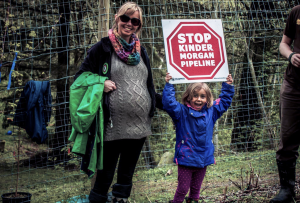
-
Joel Robertson-Taylorhttps://ufvcascade.ca/author/joel-robertson/
-
Joel Robertson-Taylorhttps://ufvcascade.ca/author/joel-robertson/
-
Joel Robertson-Taylorhttps://ufvcascade.ca/author/joel-robertson/
-
Joel Robertson-Taylorhttps://ufvcascade.ca/author/joel-robertson/

